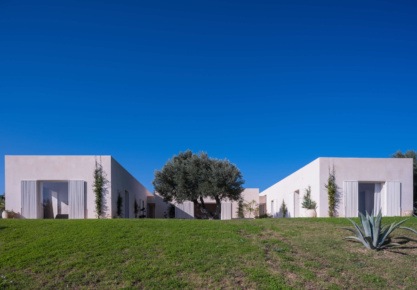The exhibition building has been conceived like a FENDI Pop Up Museum whose circular structure evokes the concept of infinity, and therefore the idea of a continuous cycle of development and renewal notions that have always been at the heart of FENDI’s philosophy and history and continue to be so today.
The external surface of the building is entirely covered with a golden polished material which creates a mimetic effect of the structure within the environment. The mirroring effect of the cylindrical container is evoked, on a different scale, by the internal set-up featuring 12 semi-cylindrical elements, in brass and glass, for displaying the furs, and 4 smaller elements for displaying the bags. These elements form a pattern, which evokes both the “roof-tiling” and the Roman cobblestone patterns, both historically tied to Fendi’s stylistic lexicon.
The choice of using repeated geometrical shapes for the set-up (in this case cylinders) is due to the fact that textures featuring repeated geometric shapes (circles, squares, etc.) were historically used in the construction of meticulous patchwork work on the back, and sometimes on the front, of fur garments. This recalls the stylistic characteristics of certain artistic movements and, in general, the sources which FENDI has looked to for inspiration and paid tribute to since the beginning: the conceptual patterns of some important Italian and American artists (i.e. Boetti and Sol Lewitt, artists in whose concepts it’s not uncommon to find artwork created by hands other than those of the artist: in fact they would often call upon skilled craftsmen for the task).
Inside this unique building, the exhibition, conceived to be both didactical and emotional, gradually develops the key concepts which FENDI embodies so distinctively: tradition, research, innovation and exclusivity.




